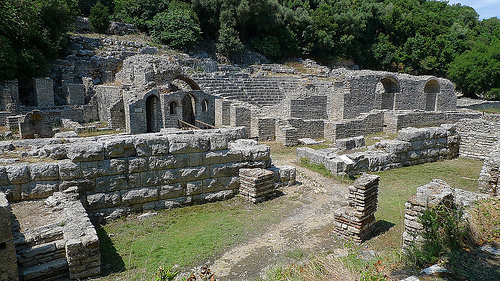

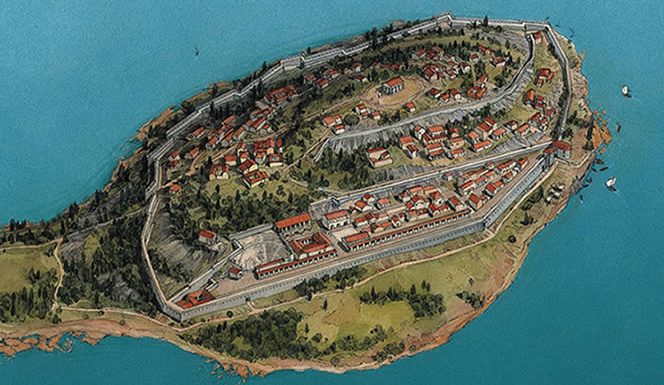
The ancient city-museum of Butrint is located near Saranda
(18 km), on the shores of a beautiful lake. The city was founded by
the Greeks in the 7th century BC. Later, one of the trade routes of
international importance passed here.
Butrint can be seen as
a microcosm of European history, as it demonstrates visible evidence
of the existence of most of the major empires that dominated the
area - Greek, Roman, Byzantine and Ottoman. The most interesting
exhibits to be seen in Butrint include the Greek amphitheater (later
rebuilt by the Romans), the baptistery, cathedral, gate, and a
museum with many interesting artifacts found in the area. Next to
the amphitheater of the ancient Greeks in the forest area there is a
Roman theater, the floors of the baths, decorated with mosaics, are
in excellent condition. The remains of the walls are replete with
inscriptions in Greek, and the baptistery - with floral motives and
images of animals. The traditional architecture of ancient cities
can be traced in the ruins of aqueducts and fountains. In memory of
the presence of the Turks, the acropolis and the fortress of the
19th century, built by the order of Ali Pasha, remained.
Butrint is one of several places in Albania that was closed to local
residents during the communist era. The city was developed as a
tourist destination for foreigners, but Albanian citizens were not
allowed here due to fears that they would try to swim to Greece.
This circumstance and the surrounding lush vegetation made it
possible to preserve the ancient ruins in very good condition.

Location: 14 km South of the Saranda, Vlore Province
Price: 700 lek for foreigners
500 lek for foreigners in a
group of more than 10 people
200 lek for citizens of Albania
Open: 9-16
Tel. +355 852 4600Email:
butrint@albaniaonline.net
Butrint or Butrotum stands 14 km south of Saranda in the Vlora
Region in Albania. This Archaeological National Park is a UNESCO
World Heritage Site. The earliest traces of human presence date back
to the 12th century BC. According to the Roman writer Virgil, the
city was founded by Elen, the son of Priam, the legendary king of
Troy. After losing the Trojan War, the Trojans fled here from the
Greeks. According to another legend, another refugee from Troy,
Aenius visited this city during his attempt to escape away from the
Greeks. In the future, he founded the city from which the founders
of Rome came out. This legend is visible was invented by the Romans
themselves, in order to justify their capture of this beautiful city
in 228 BC.
According to Virgil, Butrint was founded by Aeneas. His long correspondence with Cicero reveals his efforts to protect the properties and interests of the Butrotas against Caesar's attempts to establish a Roman colony there. Subsequently, the fortified Butrint of this period has continuously served as a shelter for the settlers and citizens living in the city. During the period of the civil wars, Butrint is mentioned by Caesar in his work as one of the main supply bases and strategic points for the mastery of the Corfu canal. The good geographical and climatic conditions gave a rapid development to the city of Butrint in the first centuries of our era. For the first time Butrint minted bronze coins in the time of Augustus, where in one of them the emperor appears on one side and on the other side a water supply. Evidence of the level of development of Butrint are the ruins of ancient monuments and various objects, preserved from that period. At the beginning of the 1st century 3 km water supply was built. long, supplying the town with water from the springs of the village of Xare near Butrint. At this time the theater stage was rebuilt. Numerous were the public and social constructions such as the baths and the temple of Asklep on the ruins of an older temple. About the 2nd century a nymph (water source) was built, which was supplied with water from the aqueduct and the gymnasium near the Gate with the Tower. There are a number of different apartments and buildings in this period, where a building with an atrium stands out in the city center near the theater. During this period, the constructions became very dense, which extended to the edge of the Vivari canal. The continuity of life until Late Antiquity is evidenced by the archaeological material excavated, where the cultural layer of the 4 century is seen. This layer reflects a density of constructions, while the large number of coins found indicates an intensification of trade development. Starting from the 3rd century. Butrint is mentioned in various road itineraries with names like Buthroto, Buthrotum etc. In 516 it is mentioned as an episcopal center, while in the period of Justinian it is mentioned by Hierocles among the 12 cities of Old Epirus in the form of Butrytos. Butrint retained its economic importance in Late Antiquity, perhaps also because it was little affected by barbarian attacks, especially by Totila, when they landed from Korkyra to Onhezem in 551. In Late Antiquity, Butrint experienced a period expansion and flowering, during which the reconstruction of the defensive walls damaged over the years took place. Monuments that testify to the development of the city in this period are the baptistery and two early Christian basilicas. The baptistery was built around the middle of the century. V. and represents the best architectural and artistic traditions of Butrint. The Acropolis Basilica was built in the late 4th century and has been paved with mosaics. The Great Basilica was built in the lower city in the 6th century and is a magnificent early Christian building. The fact that its walls have been preserved at the original height to this day, shows the continued use of the monument until the centuries of the Early Middle Ages.
In the middle of the III century, under the rule of
Emperor Decis, Butrot is mentioned in connection with the well of
Saint Terin, who was a native Christian who was condemned to be torn
apart by savages in the city theater. The chronicles of the time
describe the fact that the savages bowed before Saint Terin just as
they once did before Daniel. For these reasons Saint Terini entered
the ranks of the saints very early, a fact that is evidenced, among
other things, by his appearance in a mosaic of the century. V in the
church of Saint George in Thessaloniki and a fresco in the church of
Saint Thanas in Peca.
The medieval period is documented more
vaguely. The city was first involved in power struggles between the
Byzantines and then the Normans, Anjouans, Venetians and secondly,
in the conflict between Venice and the Ottoman Turks.
At the beginning of the XIX century, Butrint was gradually
transformed into a small fishing village, around a Venetian
fortification, but the contours of the magnificent monuments of the
past spoke of the extinction of a former splendor in this urban
center dividing the Corfu Channel. Butrint, along with Corfu, was
purchased by the Venetian Republic from the Anjouan kings of
southern Italy in 1386. By then the most active phase of the
medieval city had become an outpost of the great fortresses in
Corfu. It remained the property of Venice for more than 400 years
and the Venetians built many existing fortifications, as well as a
triangular castle, later reconstructed for the purposes of
protection and control of the Vivari Canal by the Pasha of Ioannina,
Ali Pasha Tepelena. With the empowerment of the Ottoman Empire,
Butrint remained on the front line of Venice. It was conquered on a
number of occasions, but the most notable is its capture by Suleiman
the Magnificent in 1537.
In the years 1926–1936 the Italian
Luigi Ugolini led the excavation mission in the south of Albania,
Ugolini focused on Finiq and Butrint where he was discovered: the
Baptistery, Theater, Basilica, Statue and various valuable objects,
public baths and a large number housing. Ugolini left an extensive
information about the settlements in the south of the country,
published several volumes, two of these publications were dedicated
to Finiq and Butrint entitled (Ancient Albania). In 1936 Ugolin's
excavations were stopped, in later years it was Domenico Mustili who
carried out some excavations but found nothing of value. From the
few records that result for that period it is said that Butrint in
the 3rd Century, extended to the surrounding area on the south side
of the hill that was located, were built in that period the Theater
and a Greek temple. The area around Butrint had developed
agriculture. The lands around Butrint attracted the attention of the
Romans who in the 40s of the 1st century BC, turned Butrint into a
Roman colony. Julius Caesar's legions landed in Butrint and a large
part of the wealth and population was Romanized. In the 2nd and 3rd
centuries public baths were built, the theater and other facilities
were rebuilt. The most valuable works that were discovered in the
Butrint Theater are: the statue of Apollo, the Goddess of Butrint,
some marble heads like the one of Zeus, the Portrait of Agrippa,
were discovered and numerous inscriptions in Latin and Greek. In the
5th century a part of the city was rebuilt. In the IV - XIII century
it is mentioned as an Episcopal center.
In the years
1080–1085 it was in the hands of the Normans and then the Venetians.
In the 1300s the Venetians made fortifications and maintained it
until the 1700s.
After the 1700s it fell into the hands of the French of Bonaparde and then in the years 1798 it was taken over by Ali Pasha Tepelena who built in 1807 two fortresses to be protected from the attacks of the French coming from Corfu, one of which is located in the mouth of the Canal. Vivari, passed into the hands of the Ottomans until the period of independence.
Butrint National Archaeological Park has an area of 15 hectares
and is located at altitudes 30-50 meters above sea level. It is
situated in the south-eastern corner of the Ksamil peninsula. It has
a fairly protected natural position, being bathed on both sides by
Butrint Lake, half-salted and half-sweet, and on one side by the
Vivari canal. In its composition there are many types of evergreen
trees such as laurel, prralli, ilqe, firecrackers, kullastra,
mimosa, as well as deciduous species.
The trees, which reach
a height of 12 meters, have a diameter of 60-80 centimeters and
reach a maximum age of 200 years. Butrint Cave is located near the
Saranda-Butrint highway, about 3 kilometers away from the town of
Ksamil. The cave is considered special by nature and for its
position, it is of large size. It has an area of 110 square
meters, has wide space with extensions from its entrance and is well
preserved, in natural condition. According to archaeologists, the
Butrint cave has numerous scientific values.
The Butrint
aqueduct has a length of 3.5 kilometers, a canal height of 6 meters
and a width of 3.50 meters. It is technically an accomplished
construction, where during its route many works of art have been
built, such as bridges and canals reinforced with retaining walls,
as well as decanting and control wells. In 1992 excavations in the
center of the ancient city of Butrint brought to light the Roman
city forum.
The three-room building is located in the
southern part of the Acropolis to the west of the Peristyle building
and to the east of the Roman shops. The inscription, which dates to
the first century AD, speaks of a temple dedicated to the goddess
Minerva.
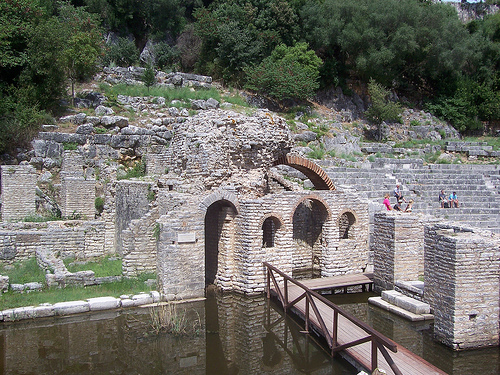
Butrint was known in the Greek World as a holy city dedicated to the god Asclepius. A temple dedicated to the god of medicine and healing stands on the south side of the hill. The whole complex of this pagan temple includes a small amphitheater, a pilgrim hotel, a holy spring and other buildings protected by its own wall.
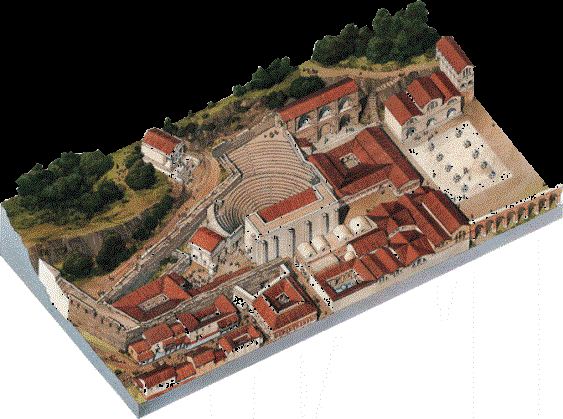
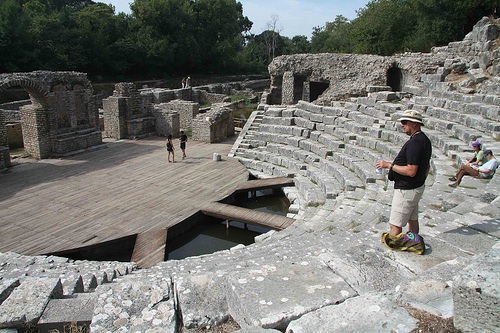
A small theater was built near the main temple dedicated to the god Asclepius. The pilgrims left part of their money, which helped build this small theater in the 4th century BC. It held theatrical performances, which were an important part of pagan ceremonies. During the Roman rule the theater was enlarged and decorated with statues. The remains of this antique building were excavated by the Italian archaeologist Luigi Maria Ugolini in 1928-30.
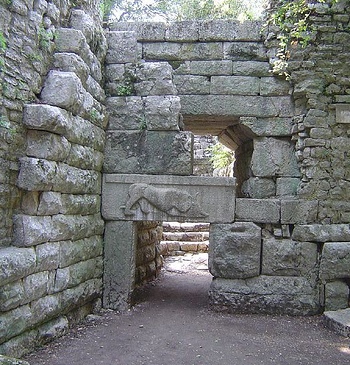
The Lion Gate got its name because of the bas-relief of a lion,
eating up the head of a bull depicted on it. This stone was
originally part of a pagan temple built in the 6th century BC.
However, the invasion of the barbarians in the 5th century AD forced
the citizens of the city to rebuild their military fortifications.
Including the gates of the city walls. Citizens dismantled the old
temple and used old stones in the fortification. Apparently the
builders were in a hurry and didn’t try hard at building. They
simply narrowed the entrance for simplified protection.
The
sacred source inside the gate was dedicated to the nymphs, the Roman
goddesses who lived in the springs, lakes and other water. The Latin
inscription dates from the 2nd century AD and says that a rich woman
gave money to decorate the source: "Junia Rufina is a friend of the
nymphs." A later inscription dates from the Christian period of the
5th and 6th centuries AD
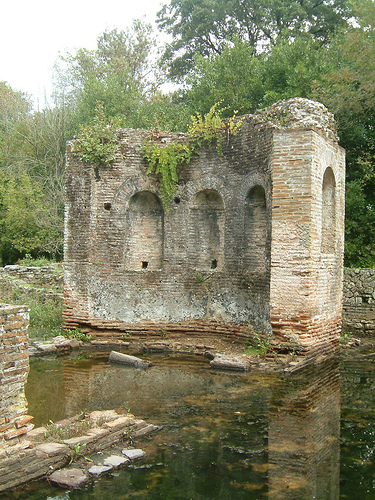
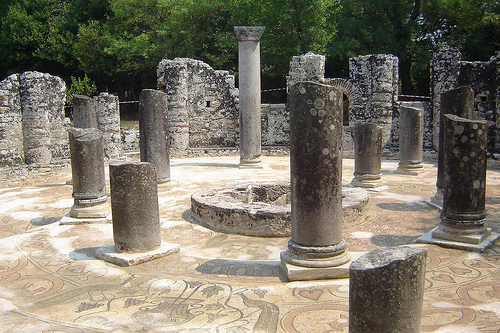
The baptistery was built in the 6th century. It is decorated with beautiful mosaics depicting animals, fish and other animals. This church was used until the 18th century.
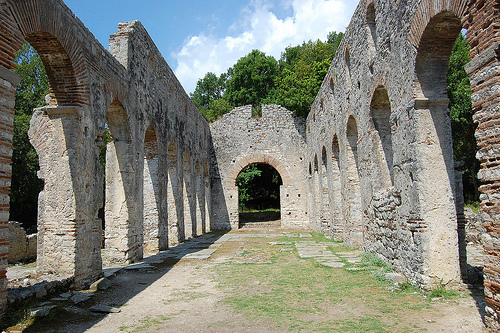
Butrint received the episcopal chair at the beginning of the 6th century. There were at least 9 Orthodox churches in the city, but the Great Basilica was the most beautiful and largest. It was built in the shape of a cross. Some of the stones were taken from the remains of an ancient pagan temple that was destroyed to build new buildings. The floor would be covered with beautiful mosaics. Part of it is still preserved.
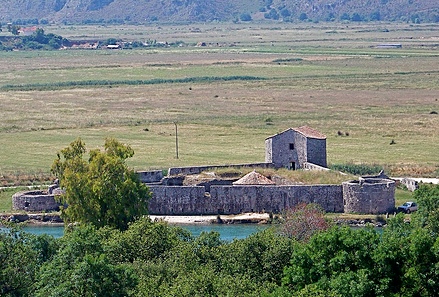
The Venetian Triangular Fortress was built by the Venetians in the 15th century to protect the Corfu Strait. Today it houses a historical museum dedicated to the history of the city from ancient times to the Middle Ages.
Anchio sailed from Ambracia and, sailing along the
coast, reached Butrot, the port of Epirus. Aeneas on the other hand,
with the most chosen soldiers, after a journey that lasted two days,
arrived in Dodona in order to seek the opinion of the god; here he
also found the Trojans who had fled with Helen. As they received
divine answers about the work of the colony, they donated to the
god, along with other Trojan gifts, copper craters, some of which
are still there today with very old inscriptions, which show the
names of the donors. From there, he then reached the ships after a
voyage that lasted more than four days…
In the late 1930s,
Italian archaeologist Ugolini mentions the legend of Butrint's
distant origins. Helen, who had come to Epirus from Troy, was
preparing to make the ritual sacrifice after landing. The cow that
was to be sacrificed to the gods, struck but not killed, escaped
from their hands and crossed the sea by swimming. Helen, seeing here
a warning from the gods, founded a city which she named Buthrotos.
According to Plutarch, the god Pan died in Butrint, and the
moment of his death became the cause of the cries of the apostles,
who informed the shepherds throughout Kaonia of this tragic loss to
the protector of forests and flowers.
In the early 1990s, the ancient city of Butrint fell prey to several thefts. Most endangered by robbers and traffickers of archeological values were some heads of marble statues and some archeological funds. Thus, the two statues of the two gods, Artemis and Apollo, two objects of rare value for Albanian culture, which 11 years ago were sent to Greece by art traffickers, were repatriated in February this year and placed in the premises of the Archaeological Museum in Butrint, 19 km from the southern city of Saranda. The two works of art, looted from the Butrint Archaeological Museum, were found in Piraeus and their traffickers have been prosecuted under Greek law. The statue of the female goddess Artemis appears in motion. Made with marble material and carving technique, according to specialists, it belongs to the Illyrian pre-urban culture, the Hellenic period, II century BC. The statue lacks 2 wings and a head. Artemis was discovered in 1958, on the hill of Finiq and was preserved until 1997 in the museum of Butrint. Its height is 1.25 meters. While the statue of Apollo, made of marble material and engraving technique, belongs to the period of the II century AD. The head was made separately and is in the Butrint Museum. It was found by the Italian archaeologist Ugolini in the Nymfeun (fountain) of Butrint. Its height is 1.38 meters. The story of the robbery of statues from Butrint and Finiqi began in 1991 and would be repeated in other dimensions in 1997. Certificates of stolen objects became part of the work of Interpol, which managed to find the location of many of them. In November 2000, the head of Livia, the wife of Emperor Octavian Augustus, was repatriated from the US, the work of the 1st century AD, (Roman period). This thanks to research for about 1 year by Auron Tare one of the founders of Butrint National Park. In the summer of 2003, at the insistence of the Minister of Culture Arta Dade and Auron Tare, it was possible to return from Greece the sculptures "Portrait of Germanic", "Portrait of Hercules" and "Portrait of a Girl", which were stolen from the Butrint Museum in 1991. "Portrait of Hercules" and "Portrait of a Girl" were found in the exhibits of the National Archaeological Museum of Athens, while "Portrait of Germanic" was found in the Archaeological Museum of Ioannina. Butrint museum staff say equipment already installed on the museum premises has shut down any possibility of looting the artwork. According to them, the Butrint museum already has modern control equipment, with cameras and alarm system and generator that guarantees the operation of the observation-signaling system "non stop".